Evaluating Fall Prevention Programs and Risk Factors
VerifiedAdded on 2021/04/24
|15
|4053
|51
AI Summary
The provided assignment evaluates the effectiveness of inpatient fall prevention programs as a patient safety strategy, incorporating various studies and guidelines. It also examines risk factors for falls in the elderly, including mobility limitations, visual impairment, and chronic musculoskeletal pain. The document aims to provide a thorough understanding of fall prevention strategies for community-dwelling older adults, highlighting the importance of assessment and management in reducing fall-related injuries.
Contribute Materials
Your contribution can guide someone’s learning journey. Share your
documents today.
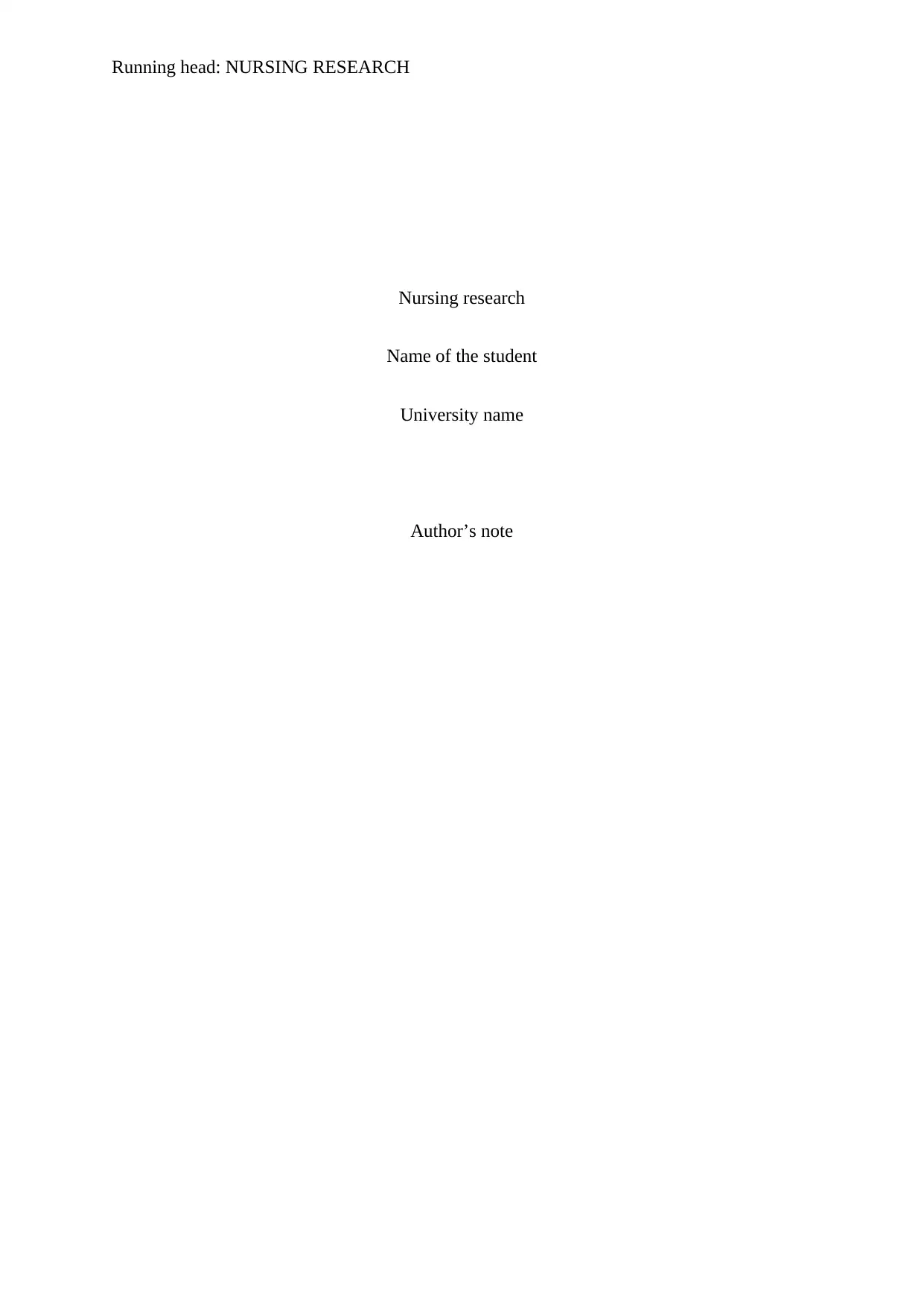
Running head: NURSING RESEARCH
Nursing research
Name of the student
University name
Author’s note
Nursing research
Name of the student
University name
Author’s note
Secure Best Marks with AI Grader
Need help grading? Try our AI Grader for instant feedback on your assignments.
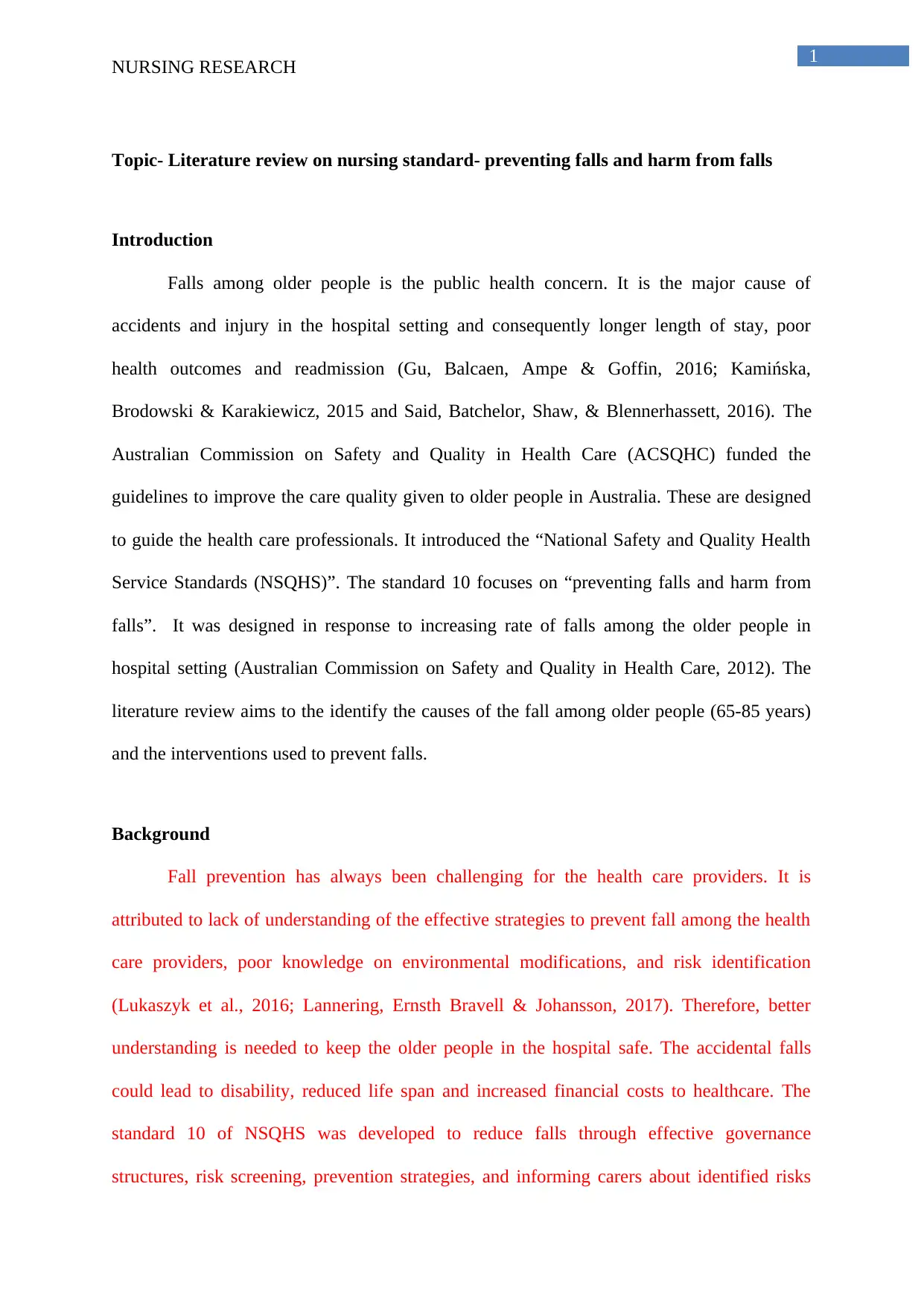
1
NURSING RESEARCH
Topic- Literature review on nursing standard- preventing falls and harm from falls
Introduction
Falls among older people is the public health concern. It is the major cause of
accidents and injury in the hospital setting and consequently longer length of stay, poor
health outcomes and readmission (Gu, Balcaen, Ampe & Goffin, 2016; Kamińska,
Brodowski & Karakiewicz, 2015 and Said, Batchelor, Shaw, & Blennerhassett, 2016). The
Australian Commission on Safety and Quality in Health Care (ACSQHC) funded the
guidelines to improve the care quality given to older people in Australia. These are designed
to guide the health care professionals. It introduced the “National Safety and Quality Health
Service Standards (NSQHS)”. The standard 10 focuses on “preventing falls and harm from
falls”. It was designed in response to increasing rate of falls among the older people in
hospital setting (Australian Commission on Safety and Quality in Health Care, 2012). The
literature review aims to the identify the causes of the fall among older people (65-85 years)
and the interventions used to prevent falls.
Background
Fall prevention has always been challenging for the health care providers. It is
attributed to lack of understanding of the effective strategies to prevent fall among the health
care providers, poor knowledge on environmental modifications, and risk identification
(Lukaszyk et al., 2016; Lannering, Ernsth Bravell & Johansson, 2017). Therefore, better
understanding is needed to keep the older people in the hospital safe. The accidental falls
could lead to disability, reduced life span and increased financial costs to healthcare. The
standard 10 of NSQHS was developed to reduce falls through effective governance
structures, risk screening, prevention strategies, and informing carers about identified risks
NURSING RESEARCH
Topic- Literature review on nursing standard- preventing falls and harm from falls
Introduction
Falls among older people is the public health concern. It is the major cause of
accidents and injury in the hospital setting and consequently longer length of stay, poor
health outcomes and readmission (Gu, Balcaen, Ampe & Goffin, 2016; Kamińska,
Brodowski & Karakiewicz, 2015 and Said, Batchelor, Shaw, & Blennerhassett, 2016). The
Australian Commission on Safety and Quality in Health Care (ACSQHC) funded the
guidelines to improve the care quality given to older people in Australia. These are designed
to guide the health care professionals. It introduced the “National Safety and Quality Health
Service Standards (NSQHS)”. The standard 10 focuses on “preventing falls and harm from
falls”. It was designed in response to increasing rate of falls among the older people in
hospital setting (Australian Commission on Safety and Quality in Health Care, 2012). The
literature review aims to the identify the causes of the fall among older people (65-85 years)
and the interventions used to prevent falls.
Background
Fall prevention has always been challenging for the health care providers. It is
attributed to lack of understanding of the effective strategies to prevent fall among the health
care providers, poor knowledge on environmental modifications, and risk identification
(Lukaszyk et al., 2016; Lannering, Ernsth Bravell & Johansson, 2017). Therefore, better
understanding is needed to keep the older people in the hospital safe. The accidental falls
could lead to disability, reduced life span and increased financial costs to healthcare. The
standard 10 of NSQHS was developed to reduce falls through effective governance
structures, risk screening, prevention strategies, and informing carers about identified risks
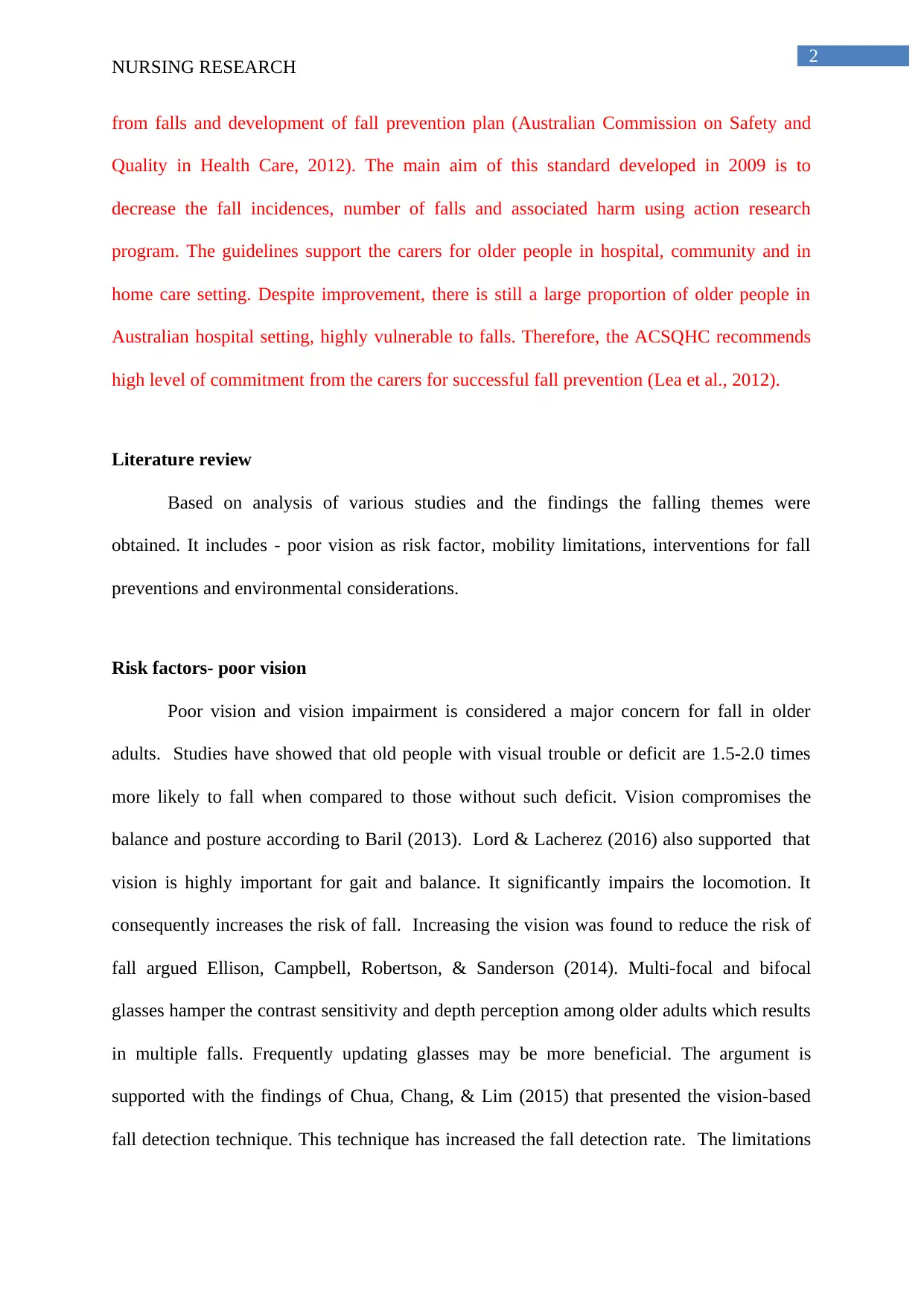
2
NURSING RESEARCH
from falls and development of fall prevention plan (Australian Commission on Safety and
Quality in Health Care, 2012). The main aim of this standard developed in 2009 is to
decrease the fall incidences, number of falls and associated harm using action research
program. The guidelines support the carers for older people in hospital, community and in
home care setting. Despite improvement, there is still a large proportion of older people in
Australian hospital setting, highly vulnerable to falls. Therefore, the ACSQHC recommends
high level of commitment from the carers for successful fall prevention (Lea et al., 2012).
Literature review
Based on analysis of various studies and the findings the falling themes were
obtained. It includes - poor vision as risk factor, mobility limitations, interventions for fall
preventions and environmental considerations.
Risk factors- poor vision
Poor vision and vision impairment is considered a major concern for fall in older
adults. Studies have showed that old people with visual trouble or deficit are 1.5-2.0 times
more likely to fall when compared to those without such deficit. Vision compromises the
balance and posture according to Baril (2013). Lord & Lacherez (2016) also supported that
vision is highly important for gait and balance. It significantly impairs the locomotion. It
consequently increases the risk of fall. Increasing the vision was found to reduce the risk of
fall argued Ellison, Campbell, Robertson, & Sanderson (2014). Multi-focal and bifocal
glasses hamper the contrast sensitivity and depth perception among older adults which results
in multiple falls. Frequently updating glasses may be more beneficial. The argument is
supported with the findings of Chua, Chang, & Lim (2015) that presented the vision-based
fall detection technique. This technique has increased the fall detection rate. The limitations
NURSING RESEARCH
from falls and development of fall prevention plan (Australian Commission on Safety and
Quality in Health Care, 2012). The main aim of this standard developed in 2009 is to
decrease the fall incidences, number of falls and associated harm using action research
program. The guidelines support the carers for older people in hospital, community and in
home care setting. Despite improvement, there is still a large proportion of older people in
Australian hospital setting, highly vulnerable to falls. Therefore, the ACSQHC recommends
high level of commitment from the carers for successful fall prevention (Lea et al., 2012).
Literature review
Based on analysis of various studies and the findings the falling themes were
obtained. It includes - poor vision as risk factor, mobility limitations, interventions for fall
preventions and environmental considerations.
Risk factors- poor vision
Poor vision and vision impairment is considered a major concern for fall in older
adults. Studies have showed that old people with visual trouble or deficit are 1.5-2.0 times
more likely to fall when compared to those without such deficit. Vision compromises the
balance and posture according to Baril (2013). Lord & Lacherez (2016) also supported that
vision is highly important for gait and balance. It significantly impairs the locomotion. It
consequently increases the risk of fall. Increasing the vision was found to reduce the risk of
fall argued Ellison, Campbell, Robertson, & Sanderson (2014). Multi-focal and bifocal
glasses hamper the contrast sensitivity and depth perception among older adults which results
in multiple falls. Frequently updating glasses may be more beneficial. The argument is
supported with the findings of Chua, Chang, & Lim (2015) that presented the vision-based
fall detection technique. This technique has increased the fall detection rate. The limitations
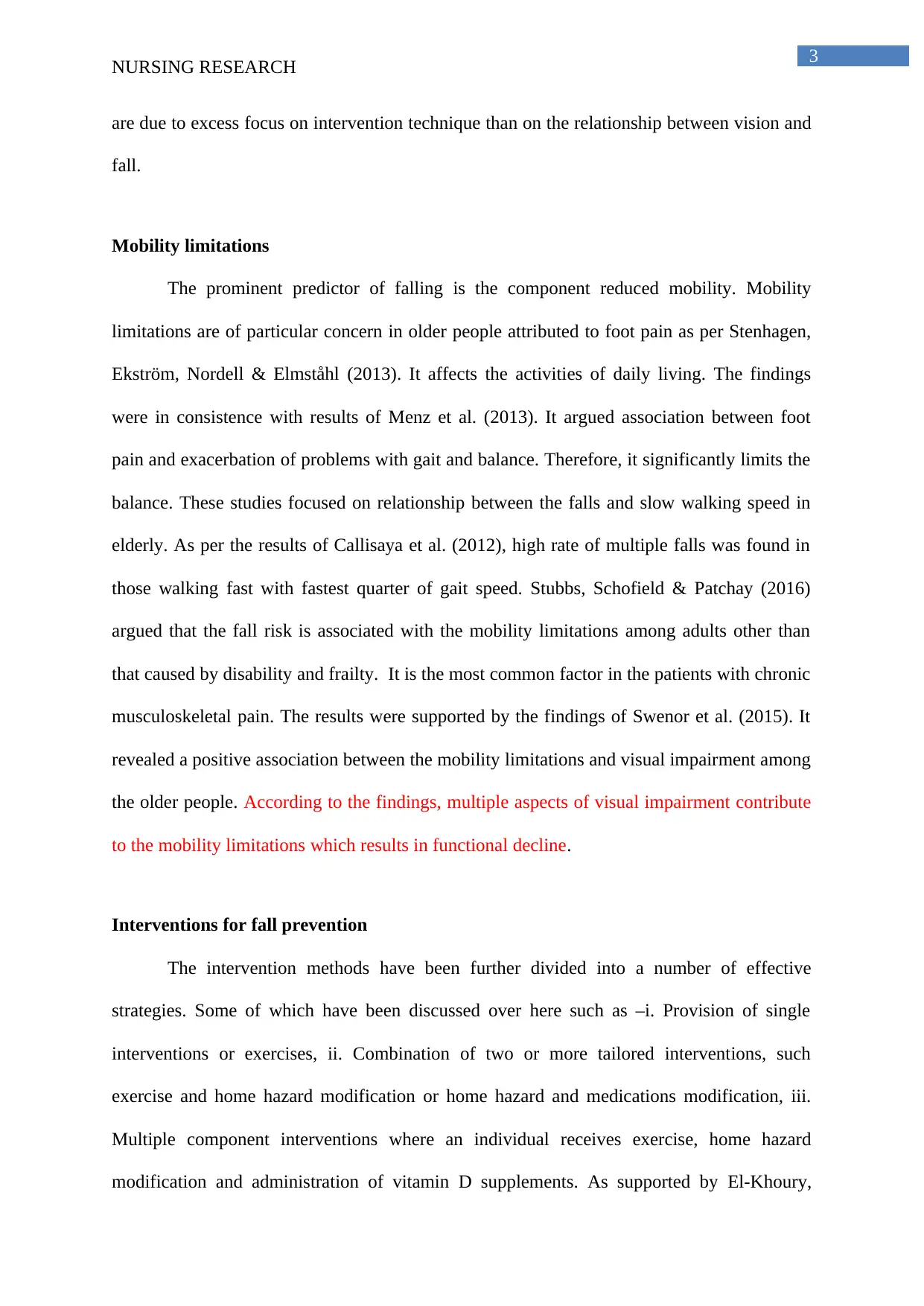
3
NURSING RESEARCH
are due to excess focus on intervention technique than on the relationship between vision and
fall.
Mobility limitations
The prominent predictor of falling is the component reduced mobility. Mobility
limitations are of particular concern in older people attributed to foot pain as per Stenhagen,
Ekström, Nordell & Elmståhl (2013). It affects the activities of daily living. The findings
were in consistence with results of Menz et al. (2013). It argued association between foot
pain and exacerbation of problems with gait and balance. Therefore, it significantly limits the
balance. These studies focused on relationship between the falls and slow walking speed in
elderly. As per the results of Callisaya et al. (2012), high rate of multiple falls was found in
those walking fast with fastest quarter of gait speed. Stubbs, Schofield & Patchay (2016)
argued that the fall risk is associated with the mobility limitations among adults other than
that caused by disability and frailty. It is the most common factor in the patients with chronic
musculoskeletal pain. The results were supported by the findings of Swenor et al. (2015). It
revealed a positive association between the mobility limitations and visual impairment among
the older people. According to the findings, multiple aspects of visual impairment contribute
to the mobility limitations which results in functional decline.
Interventions for fall prevention
The intervention methods have been further divided into a number of effective
strategies. Some of which have been discussed over here such as –i. Provision of single
interventions or exercises, ii. Combination of two or more tailored interventions, such
exercise and home hazard modification or home hazard and medications modification, iii.
Multiple component interventions where an individual receives exercise, home hazard
modification and administration of vitamin D supplements. As supported by El-Khoury,
NURSING RESEARCH
are due to excess focus on intervention technique than on the relationship between vision and
fall.
Mobility limitations
The prominent predictor of falling is the component reduced mobility. Mobility
limitations are of particular concern in older people attributed to foot pain as per Stenhagen,
Ekström, Nordell & Elmståhl (2013). It affects the activities of daily living. The findings
were in consistence with results of Menz et al. (2013). It argued association between foot
pain and exacerbation of problems with gait and balance. Therefore, it significantly limits the
balance. These studies focused on relationship between the falls and slow walking speed in
elderly. As per the results of Callisaya et al. (2012), high rate of multiple falls was found in
those walking fast with fastest quarter of gait speed. Stubbs, Schofield & Patchay (2016)
argued that the fall risk is associated with the mobility limitations among adults other than
that caused by disability and frailty. It is the most common factor in the patients with chronic
musculoskeletal pain. The results were supported by the findings of Swenor et al. (2015). It
revealed a positive association between the mobility limitations and visual impairment among
the older people. According to the findings, multiple aspects of visual impairment contribute
to the mobility limitations which results in functional decline.
Interventions for fall prevention
The intervention methods have been further divided into a number of effective
strategies. Some of which have been discussed over here such as –i. Provision of single
interventions or exercises, ii. Combination of two or more tailored interventions, such
exercise and home hazard modification or home hazard and medications modification, iii.
Multiple component interventions where an individual receives exercise, home hazard
modification and administration of vitamin D supplements. As supported by El-Khoury,
Secure Best Marks with AI Grader
Need help grading? Try our AI Grader for instant feedback on your assignments.
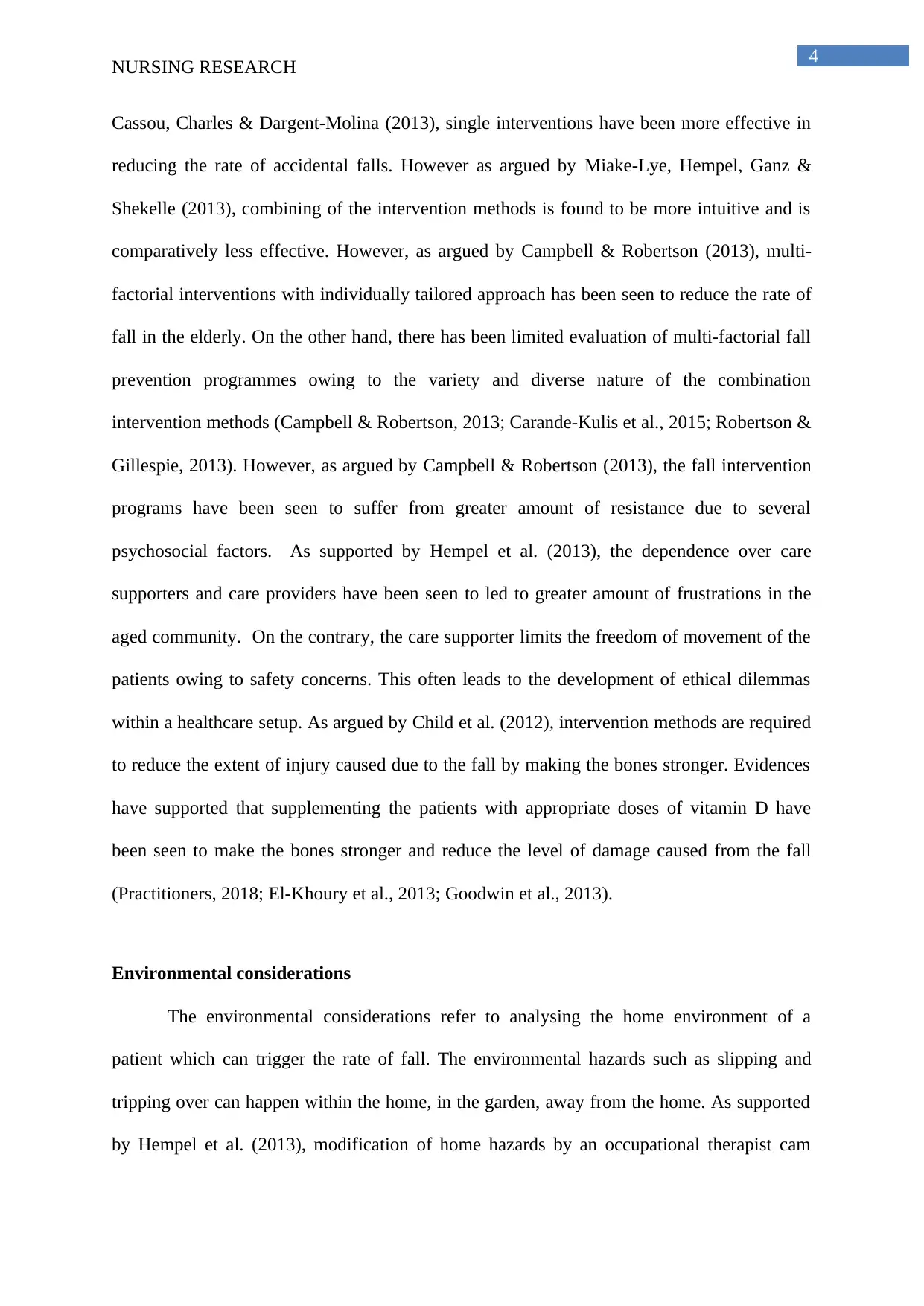
4
NURSING RESEARCH
Cassou, Charles & Dargent-Molina (2013), single interventions have been more effective in
reducing the rate of accidental falls. However as argued by Miake-Lye, Hempel, Ganz &
Shekelle (2013), combining of the intervention methods is found to be more intuitive and is
comparatively less effective. However, as argued by Campbell & Robertson (2013), multi-
factorial interventions with individually tailored approach has been seen to reduce the rate of
fall in the elderly. On the other hand, there has been limited evaluation of multi-factorial fall
prevention programmes owing to the variety and diverse nature of the combination
intervention methods (Campbell & Robertson, 2013; Carande-Kulis et al., 2015; Robertson &
Gillespie, 2013). However, as argued by Campbell & Robertson (2013), the fall intervention
programs have been seen to suffer from greater amount of resistance due to several
psychosocial factors. As supported by Hempel et al. (2013), the dependence over care
supporters and care providers have been seen to led to greater amount of frustrations in the
aged community. On the contrary, the care supporter limits the freedom of movement of the
patients owing to safety concerns. This often leads to the development of ethical dilemmas
within a healthcare setup. As argued by Child et al. (2012), intervention methods are required
to reduce the extent of injury caused due to the fall by making the bones stronger. Evidences
have supported that supplementing the patients with appropriate doses of vitamin D have
been seen to make the bones stronger and reduce the level of damage caused from the fall
(Practitioners, 2018; El-Khoury et al., 2013; Goodwin et al., 2013).
Environmental considerations
The environmental considerations refer to analysing the home environment of a
patient which can trigger the rate of fall. The environmental hazards such as slipping and
tripping over can happen within the home, in the garden, away from the home. As supported
by Hempel et al. (2013), modification of home hazards by an occupational therapist cam
NURSING RESEARCH
Cassou, Charles & Dargent-Molina (2013), single interventions have been more effective in
reducing the rate of accidental falls. However as argued by Miake-Lye, Hempel, Ganz &
Shekelle (2013), combining of the intervention methods is found to be more intuitive and is
comparatively less effective. However, as argued by Campbell & Robertson (2013), multi-
factorial interventions with individually tailored approach has been seen to reduce the rate of
fall in the elderly. On the other hand, there has been limited evaluation of multi-factorial fall
prevention programmes owing to the variety and diverse nature of the combination
intervention methods (Campbell & Robertson, 2013; Carande-Kulis et al., 2015; Robertson &
Gillespie, 2013). However, as argued by Campbell & Robertson (2013), the fall intervention
programs have been seen to suffer from greater amount of resistance due to several
psychosocial factors. As supported by Hempel et al. (2013), the dependence over care
supporters and care providers have been seen to led to greater amount of frustrations in the
aged community. On the contrary, the care supporter limits the freedom of movement of the
patients owing to safety concerns. This often leads to the development of ethical dilemmas
within a healthcare setup. As argued by Child et al. (2012), intervention methods are required
to reduce the extent of injury caused due to the fall by making the bones stronger. Evidences
have supported that supplementing the patients with appropriate doses of vitamin D have
been seen to make the bones stronger and reduce the level of damage caused from the fall
(Practitioners, 2018; El-Khoury et al., 2013; Goodwin et al., 2013).
Environmental considerations
The environmental considerations refer to analysing the home environment of a
patient which can trigger the rate of fall. The environmental hazards such as slipping and
tripping over can happen within the home, in the garden, away from the home. As supported
by Hempel et al. (2013), modification of home hazards by an occupational therapist cam
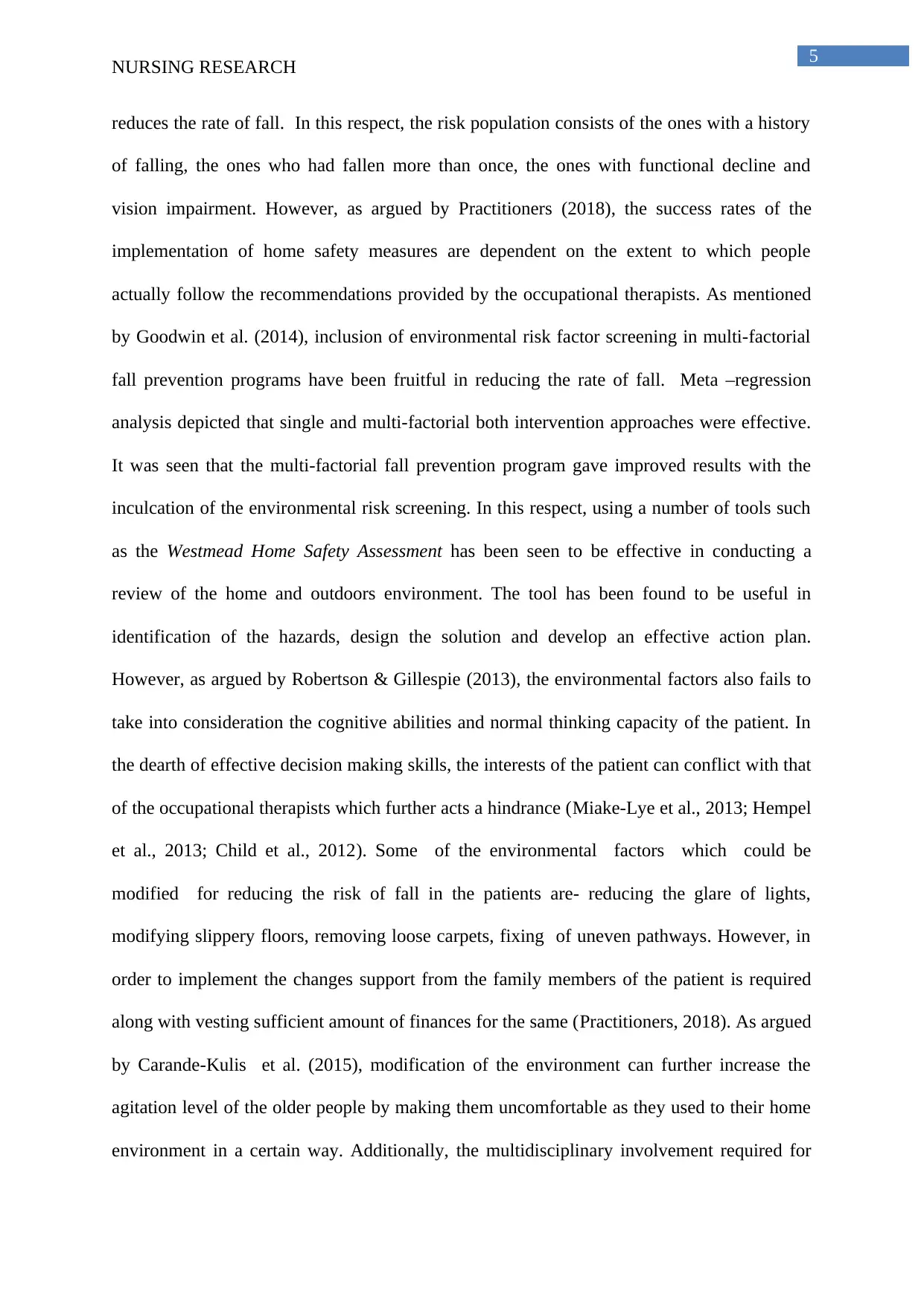
5
NURSING RESEARCH
reduces the rate of fall. In this respect, the risk population consists of the ones with a history
of falling, the ones who had fallen more than once, the ones with functional decline and
vision impairment. However, as argued by Practitioners (2018), the success rates of the
implementation of home safety measures are dependent on the extent to which people
actually follow the recommendations provided by the occupational therapists. As mentioned
by Goodwin et al. (2014), inclusion of environmental risk factor screening in multi-factorial
fall prevention programs have been fruitful in reducing the rate of fall. Meta –regression
analysis depicted that single and multi-factorial both intervention approaches were effective.
It was seen that the multi-factorial fall prevention program gave improved results with the
inculcation of the environmental risk screening. In this respect, using a number of tools such
as the Westmead Home Safety Assessment has been seen to be effective in conducting a
review of the home and outdoors environment. The tool has been found to be useful in
identification of the hazards, design the solution and develop an effective action plan.
However, as argued by Robertson & Gillespie (2013), the environmental factors also fails to
take into consideration the cognitive abilities and normal thinking capacity of the patient. In
the dearth of effective decision making skills, the interests of the patient can conflict with that
of the occupational therapists which further acts a hindrance (Miake-Lye et al., 2013; Hempel
et al., 2013; Child et al., 2012). Some of the environmental factors which could be
modified for reducing the risk of fall in the patients are- reducing the glare of lights,
modifying slippery floors, removing loose carpets, fixing of uneven pathways. However, in
order to implement the changes support from the family members of the patient is required
along with vesting sufficient amount of finances for the same (Practitioners, 2018). As argued
by Carande-Kulis et al. (2015), modification of the environment can further increase the
agitation level of the older people by making them uncomfortable as they used to their home
environment in a certain way. Additionally, the multidisciplinary involvement required for
NURSING RESEARCH
reduces the rate of fall. In this respect, the risk population consists of the ones with a history
of falling, the ones who had fallen more than once, the ones with functional decline and
vision impairment. However, as argued by Practitioners (2018), the success rates of the
implementation of home safety measures are dependent on the extent to which people
actually follow the recommendations provided by the occupational therapists. As mentioned
by Goodwin et al. (2014), inclusion of environmental risk factor screening in multi-factorial
fall prevention programs have been fruitful in reducing the rate of fall. Meta –regression
analysis depicted that single and multi-factorial both intervention approaches were effective.
It was seen that the multi-factorial fall prevention program gave improved results with the
inculcation of the environmental risk screening. In this respect, using a number of tools such
as the Westmead Home Safety Assessment has been seen to be effective in conducting a
review of the home and outdoors environment. The tool has been found to be useful in
identification of the hazards, design the solution and develop an effective action plan.
However, as argued by Robertson & Gillespie (2013), the environmental factors also fails to
take into consideration the cognitive abilities and normal thinking capacity of the patient. In
the dearth of effective decision making skills, the interests of the patient can conflict with that
of the occupational therapists which further acts a hindrance (Miake-Lye et al., 2013; Hempel
et al., 2013; Child et al., 2012). Some of the environmental factors which could be
modified for reducing the risk of fall in the patients are- reducing the glare of lights,
modifying slippery floors, removing loose carpets, fixing of uneven pathways. However, in
order to implement the changes support from the family members of the patient is required
along with vesting sufficient amount of finances for the same (Practitioners, 2018). As argued
by Carande-Kulis et al. (2015), modification of the environment can further increase the
agitation level of the older people by making them uncomfortable as they used to their home
environment in a certain way. Additionally, the multidisciplinary involvement required for
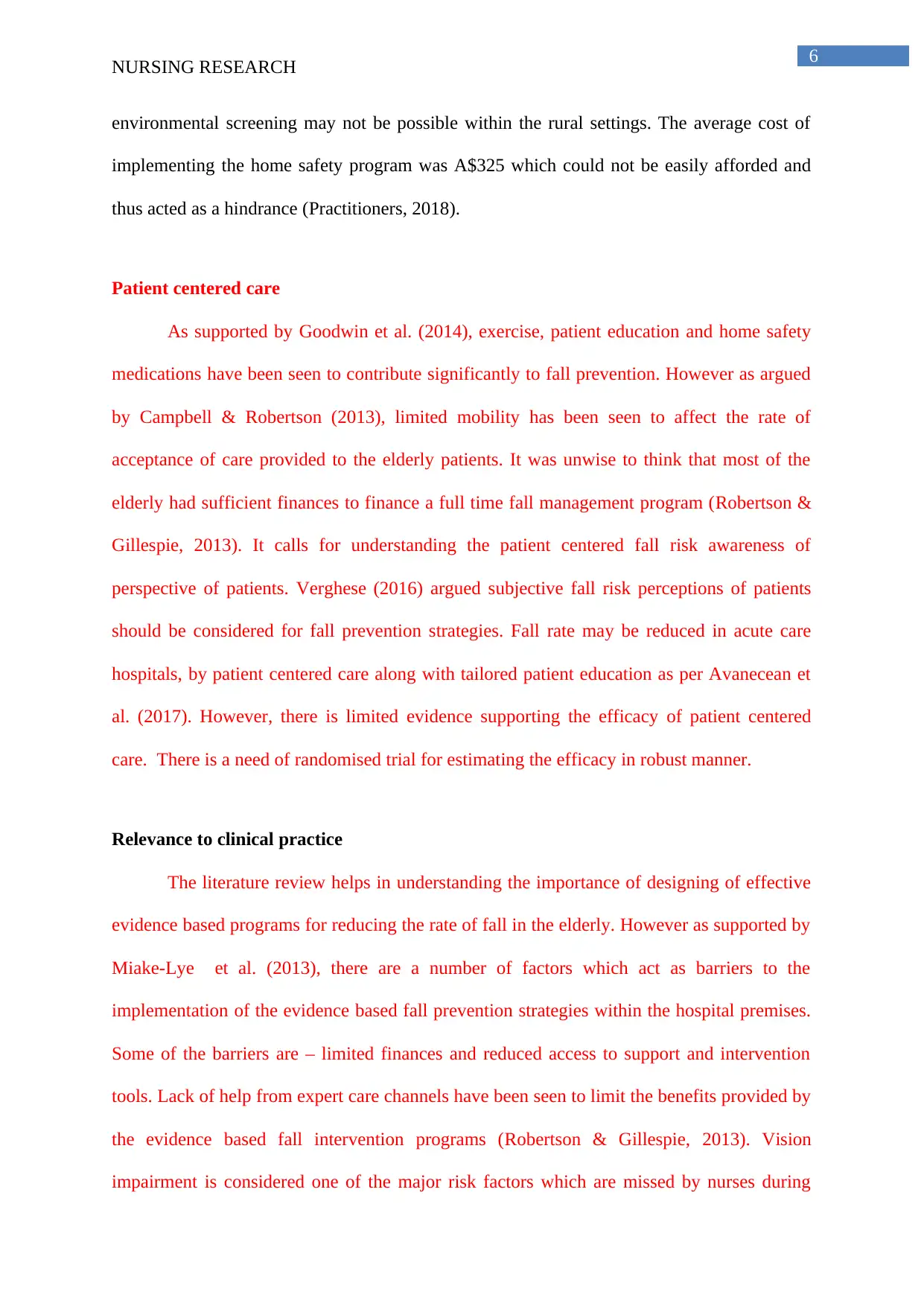
6
NURSING RESEARCH
environmental screening may not be possible within the rural settings. The average cost of
implementing the home safety program was A$325 which could not be easily afforded and
thus acted as a hindrance (Practitioners, 2018).
Patient centered care
As supported by Goodwin et al. (2014), exercise, patient education and home safety
medications have been seen to contribute significantly to fall prevention. However as argued
by Campbell & Robertson (2013), limited mobility has been seen to affect the rate of
acceptance of care provided to the elderly patients. It was unwise to think that most of the
elderly had sufficient finances to finance a full time fall management program (Robertson &
Gillespie, 2013). It calls for understanding the patient centered fall risk awareness of
perspective of patients. Verghese (2016) argued subjective fall risk perceptions of patients
should be considered for fall prevention strategies. Fall rate may be reduced in acute care
hospitals, by patient centered care along with tailored patient education as per Avanecean et
al. (2017). However, there is limited evidence supporting the efficacy of patient centered
care. There is a need of randomised trial for estimating the efficacy in robust manner.
Relevance to clinical practice
The literature review helps in understanding the importance of designing of effective
evidence based programs for reducing the rate of fall in the elderly. However as supported by
Miake-Lye et al. (2013), there are a number of factors which act as barriers to the
implementation of the evidence based fall prevention strategies within the hospital premises.
Some of the barriers are – limited finances and reduced access to support and intervention
tools. Lack of help from expert care channels have been seen to limit the benefits provided by
the evidence based fall intervention programs (Robertson & Gillespie, 2013). Vision
impairment is considered one of the major risk factors which are missed by nurses during
NURSING RESEARCH
environmental screening may not be possible within the rural settings. The average cost of
implementing the home safety program was A$325 which could not be easily afforded and
thus acted as a hindrance (Practitioners, 2018).
Patient centered care
As supported by Goodwin et al. (2014), exercise, patient education and home safety
medications have been seen to contribute significantly to fall prevention. However as argued
by Campbell & Robertson (2013), limited mobility has been seen to affect the rate of
acceptance of care provided to the elderly patients. It was unwise to think that most of the
elderly had sufficient finances to finance a full time fall management program (Robertson &
Gillespie, 2013). It calls for understanding the patient centered fall risk awareness of
perspective of patients. Verghese (2016) argued subjective fall risk perceptions of patients
should be considered for fall prevention strategies. Fall rate may be reduced in acute care
hospitals, by patient centered care along with tailored patient education as per Avanecean et
al. (2017). However, there is limited evidence supporting the efficacy of patient centered
care. There is a need of randomised trial for estimating the efficacy in robust manner.
Relevance to clinical practice
The literature review helps in understanding the importance of designing of effective
evidence based programs for reducing the rate of fall in the elderly. However as supported by
Miake-Lye et al. (2013), there are a number of factors which act as barriers to the
implementation of the evidence based fall prevention strategies within the hospital premises.
Some of the barriers are – limited finances and reduced access to support and intervention
tools. Lack of help from expert care channels have been seen to limit the benefits provided by
the evidence based fall intervention programs (Robertson & Gillespie, 2013). Vision
impairment is considered one of the major risk factors which are missed by nurses during
Paraphrase This Document
Need a fresh take? Get an instant paraphrase of this document with our AI Paraphraser
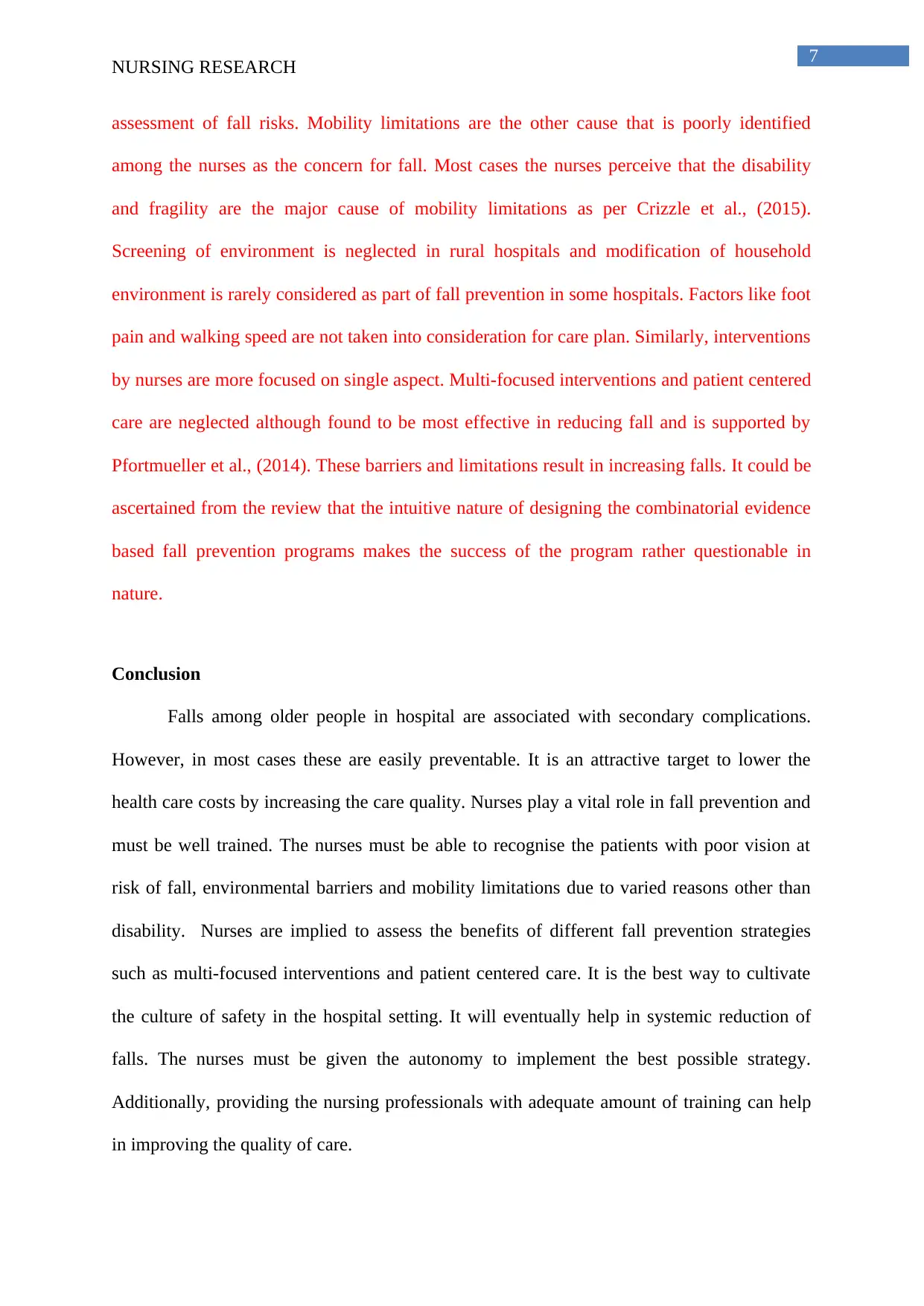
7
NURSING RESEARCH
assessment of fall risks. Mobility limitations are the other cause that is poorly identified
among the nurses as the concern for fall. Most cases the nurses perceive that the disability
and fragility are the major cause of mobility limitations as per Crizzle et al., (2015).
Screening of environment is neglected in rural hospitals and modification of household
environment is rarely considered as part of fall prevention in some hospitals. Factors like foot
pain and walking speed are not taken into consideration for care plan. Similarly, interventions
by nurses are more focused on single aspect. Multi-focused interventions and patient centered
care are neglected although found to be most effective in reducing fall and is supported by
Pfortmueller et al., (2014). These barriers and limitations result in increasing falls. It could be
ascertained from the review that the intuitive nature of designing the combinatorial evidence
based fall prevention programs makes the success of the program rather questionable in
nature.
Conclusion
Falls among older people in hospital are associated with secondary complications.
However, in most cases these are easily preventable. It is an attractive target to lower the
health care costs by increasing the care quality. Nurses play a vital role in fall prevention and
must be well trained. The nurses must be able to recognise the patients with poor vision at
risk of fall, environmental barriers and mobility limitations due to varied reasons other than
disability. Nurses are implied to assess the benefits of different fall prevention strategies
such as multi-focused interventions and patient centered care. It is the best way to cultivate
the culture of safety in the hospital setting. It will eventually help in systemic reduction of
falls. The nurses must be given the autonomy to implement the best possible strategy.
Additionally, providing the nursing professionals with adequate amount of training can help
in improving the quality of care.
NURSING RESEARCH
assessment of fall risks. Mobility limitations are the other cause that is poorly identified
among the nurses as the concern for fall. Most cases the nurses perceive that the disability
and fragility are the major cause of mobility limitations as per Crizzle et al., (2015).
Screening of environment is neglected in rural hospitals and modification of household
environment is rarely considered as part of fall prevention in some hospitals. Factors like foot
pain and walking speed are not taken into consideration for care plan. Similarly, interventions
by nurses are more focused on single aspect. Multi-focused interventions and patient centered
care are neglected although found to be most effective in reducing fall and is supported by
Pfortmueller et al., (2014). These barriers and limitations result in increasing falls. It could be
ascertained from the review that the intuitive nature of designing the combinatorial evidence
based fall prevention programs makes the success of the program rather questionable in
nature.
Conclusion
Falls among older people in hospital are associated with secondary complications.
However, in most cases these are easily preventable. It is an attractive target to lower the
health care costs by increasing the care quality. Nurses play a vital role in fall prevention and
must be well trained. The nurses must be able to recognise the patients with poor vision at
risk of fall, environmental barriers and mobility limitations due to varied reasons other than
disability. Nurses are implied to assess the benefits of different fall prevention strategies
such as multi-focused interventions and patient centered care. It is the best way to cultivate
the culture of safety in the hospital setting. It will eventually help in systemic reduction of
falls. The nurses must be given the autonomy to implement the best possible strategy.
Additionally, providing the nursing professionals with adequate amount of training can help
in improving the quality of care.

8
NURSING RESEARCH
NURSING RESEARCH
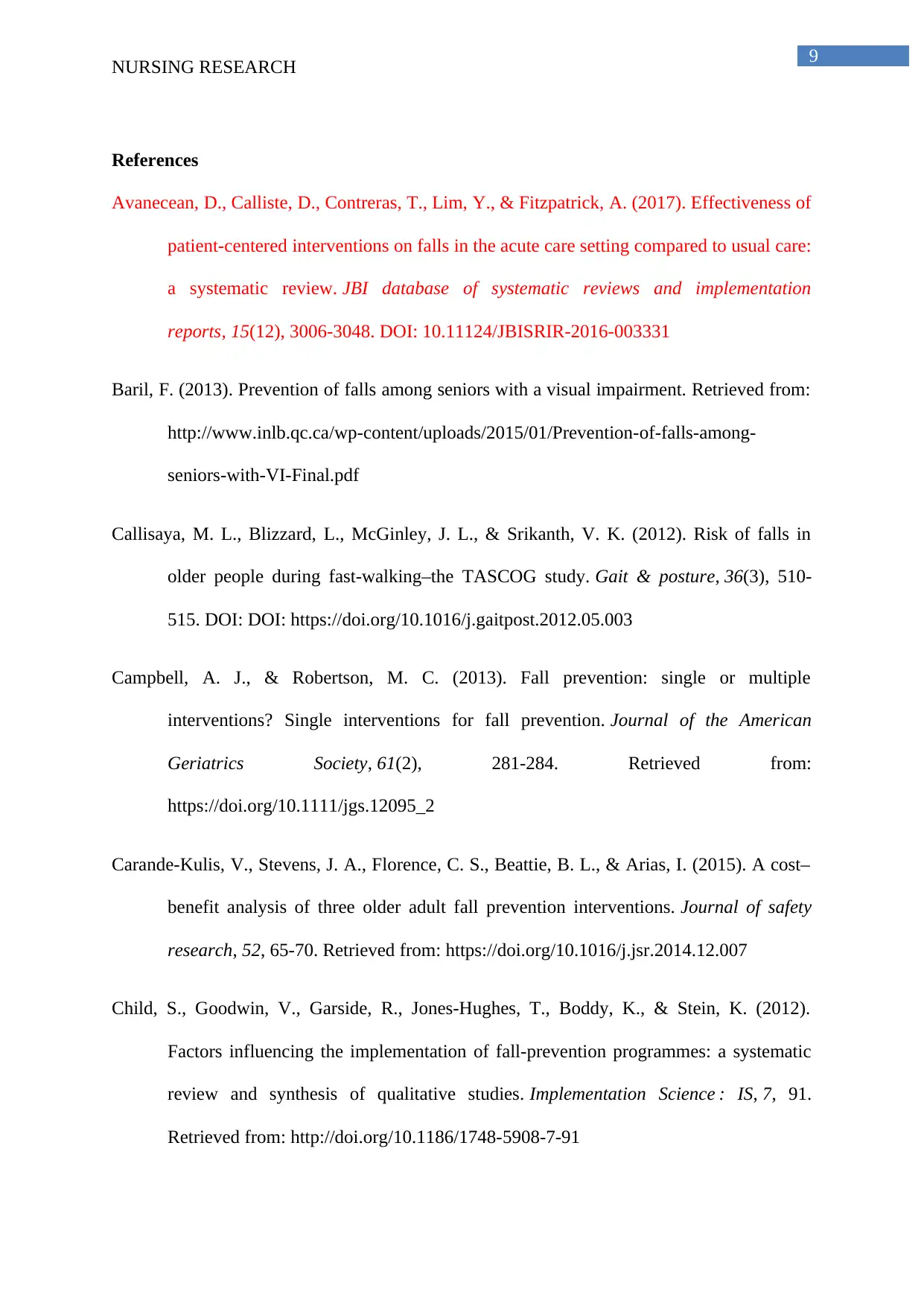
9
NURSING RESEARCH
References
Avanecean, D., Calliste, D., Contreras, T., Lim, Y., & Fitzpatrick, A. (2017). Effectiveness of
patient-centered interventions on falls in the acute care setting compared to usual care:
a systematic review. JBI database of systematic reviews and implementation
reports, 15(12), 3006-3048. DOI: 10.11124/JBISRIR-2016-003331
Baril, F. (2013). Prevention of falls among seniors with a visual impairment. Retrieved from:
http://www.inlb.qc.ca/wp-content/uploads/2015/01/Prevention-of-falls-among-
seniors-with-VI-Final.pdf
Callisaya, M. L., Blizzard, L., McGinley, J. L., & Srikanth, V. K. (2012). Risk of falls in
older people during fast-walking–the TASCOG study. Gait & posture, 36(3), 510-
515. DOI: DOI: https://doi.org/10.1016/j.gaitpost.2012.05.003
Campbell, A. J., & Robertson, M. C. (2013). Fall prevention: single or multiple
interventions? Single interventions for fall prevention. Journal of the American
Geriatrics Society, 61(2), 281-284. Retrieved from:
https://doi.org/10.1111/jgs.12095_2
Carande-Kulis, V., Stevens, J. A., Florence, C. S., Beattie, B. L., & Arias, I. (2015). A cost–
benefit analysis of three older adult fall prevention interventions. Journal of safety
research, 52, 65-70. Retrieved from: https://doi.org/10.1016/j.jsr.2014.12.007
Child, S., Goodwin, V., Garside, R., Jones-Hughes, T., Boddy, K., & Stein, K. (2012).
Factors influencing the implementation of fall-prevention programmes: a systematic
review and synthesis of qualitative studies. Implementation Science : IS, 7, 91.
Retrieved from: http://doi.org/10.1186/1748-5908-7-91
NURSING RESEARCH
References
Avanecean, D., Calliste, D., Contreras, T., Lim, Y., & Fitzpatrick, A. (2017). Effectiveness of
patient-centered interventions on falls in the acute care setting compared to usual care:
a systematic review. JBI database of systematic reviews and implementation
reports, 15(12), 3006-3048. DOI: 10.11124/JBISRIR-2016-003331
Baril, F. (2013). Prevention of falls among seniors with a visual impairment. Retrieved from:
http://www.inlb.qc.ca/wp-content/uploads/2015/01/Prevention-of-falls-among-
seniors-with-VI-Final.pdf
Callisaya, M. L., Blizzard, L., McGinley, J. L., & Srikanth, V. K. (2012). Risk of falls in
older people during fast-walking–the TASCOG study. Gait & posture, 36(3), 510-
515. DOI: DOI: https://doi.org/10.1016/j.gaitpost.2012.05.003
Campbell, A. J., & Robertson, M. C. (2013). Fall prevention: single or multiple
interventions? Single interventions for fall prevention. Journal of the American
Geriatrics Society, 61(2), 281-284. Retrieved from:
https://doi.org/10.1111/jgs.12095_2
Carande-Kulis, V., Stevens, J. A., Florence, C. S., Beattie, B. L., & Arias, I. (2015). A cost–
benefit analysis of three older adult fall prevention interventions. Journal of safety
research, 52, 65-70. Retrieved from: https://doi.org/10.1016/j.jsr.2014.12.007
Child, S., Goodwin, V., Garside, R., Jones-Hughes, T., Boddy, K., & Stein, K. (2012).
Factors influencing the implementation of fall-prevention programmes: a systematic
review and synthesis of qualitative studies. Implementation Science : IS, 7, 91.
Retrieved from: http://doi.org/10.1186/1748-5908-7-91
Secure Best Marks with AI Grader
Need help grading? Try our AI Grader for instant feedback on your assignments.
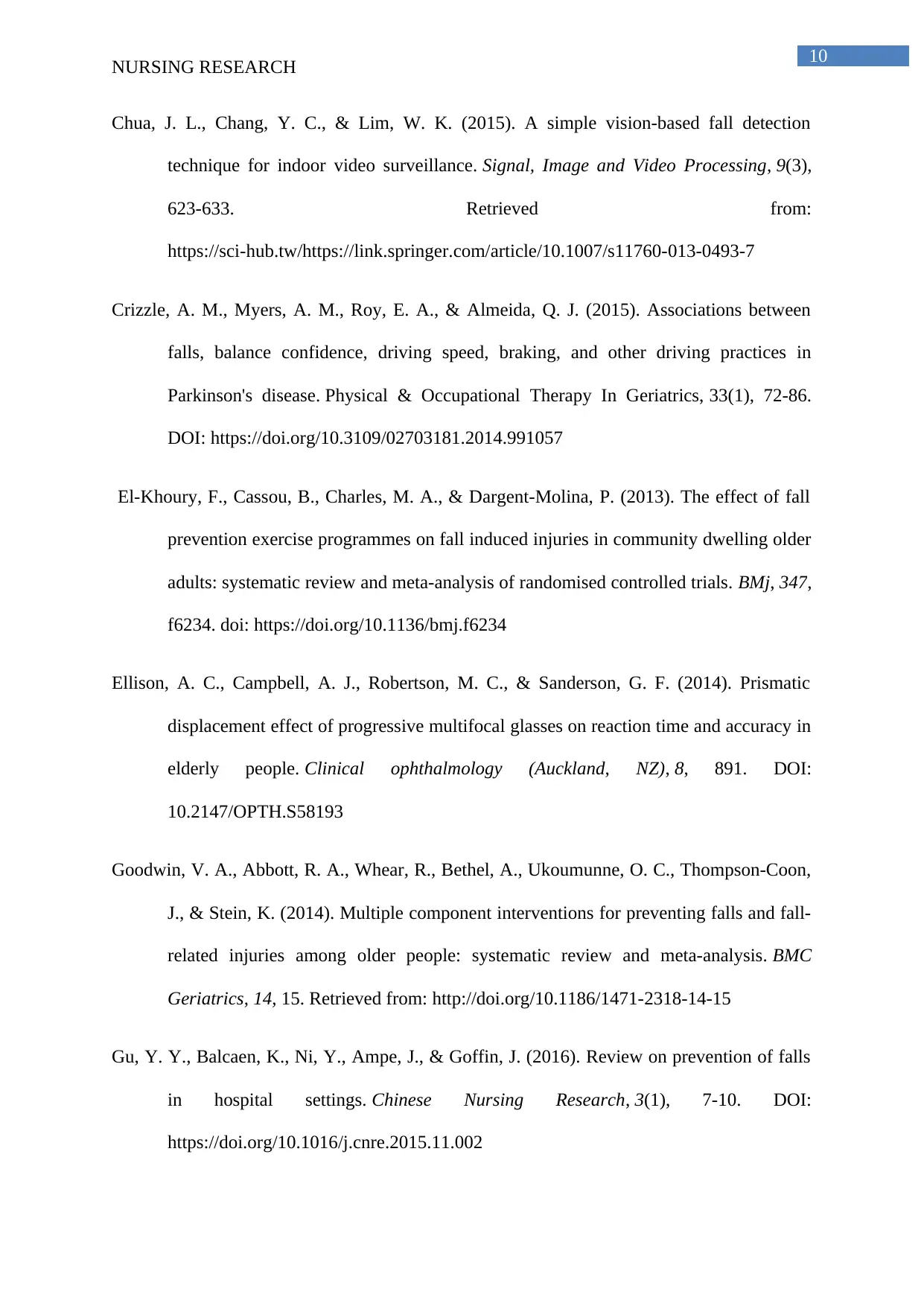
10
NURSING RESEARCH
Chua, J. L., Chang, Y. C., & Lim, W. K. (2015). A simple vision-based fall detection
technique for indoor video surveillance. Signal, Image and Video Processing, 9(3),
623-633. Retrieved from:
https://sci-hub.tw/https://link.springer.com/article/10.1007/s11760-013-0493-7
Crizzle, A. M., Myers, A. M., Roy, E. A., & Almeida, Q. J. (2015). Associations between
falls, balance confidence, driving speed, braking, and other driving practices in
Parkinson's disease. Physical & Occupational Therapy In Geriatrics, 33(1), 72-86.
DOI: https://doi.org/10.3109/02703181.2014.991057
El-Khoury, F., Cassou, B., Charles, M. A., & Dargent-Molina, P. (2013). The effect of fall
prevention exercise programmes on fall induced injuries in community dwelling older
adults: systematic review and meta-analysis of randomised controlled trials. BMj, 347,
f6234. doi: https://doi.org/10.1136/bmj.f6234
Ellison, A. C., Campbell, A. J., Robertson, M. C., & Sanderson, G. F. (2014). Prismatic
displacement effect of progressive multifocal glasses on reaction time and accuracy in
elderly people. Clinical ophthalmology (Auckland, NZ), 8, 891. DOI:
10.2147/OPTH.S58193
Goodwin, V. A., Abbott, R. A., Whear, R., Bethel, A., Ukoumunne, O. C., Thompson-Coon,
J., & Stein, K. (2014). Multiple component interventions for preventing falls and fall-
related injuries among older people: systematic review and meta-analysis. BMC
Geriatrics, 14, 15. Retrieved from: http://doi.org/10.1186/1471-2318-14-15
Gu, Y. Y., Balcaen, K., Ni, Y., Ampe, J., & Goffin, J. (2016). Review on prevention of falls
in hospital settings. Chinese Nursing Research, 3(1), 7-10. DOI:
https://doi.org/10.1016/j.cnre.2015.11.002
NURSING RESEARCH
Chua, J. L., Chang, Y. C., & Lim, W. K. (2015). A simple vision-based fall detection
technique for indoor video surveillance. Signal, Image and Video Processing, 9(3),
623-633. Retrieved from:
https://sci-hub.tw/https://link.springer.com/article/10.1007/s11760-013-0493-7
Crizzle, A. M., Myers, A. M., Roy, E. A., & Almeida, Q. J. (2015). Associations between
falls, balance confidence, driving speed, braking, and other driving practices in
Parkinson's disease. Physical & Occupational Therapy In Geriatrics, 33(1), 72-86.
DOI: https://doi.org/10.3109/02703181.2014.991057
El-Khoury, F., Cassou, B., Charles, M. A., & Dargent-Molina, P. (2013). The effect of fall
prevention exercise programmes on fall induced injuries in community dwelling older
adults: systematic review and meta-analysis of randomised controlled trials. BMj, 347,
f6234. doi: https://doi.org/10.1136/bmj.f6234
Ellison, A. C., Campbell, A. J., Robertson, M. C., & Sanderson, G. F. (2014). Prismatic
displacement effect of progressive multifocal glasses on reaction time and accuracy in
elderly people. Clinical ophthalmology (Auckland, NZ), 8, 891. DOI:
10.2147/OPTH.S58193
Goodwin, V. A., Abbott, R. A., Whear, R., Bethel, A., Ukoumunne, O. C., Thompson-Coon,
J., & Stein, K. (2014). Multiple component interventions for preventing falls and fall-
related injuries among older people: systematic review and meta-analysis. BMC
Geriatrics, 14, 15. Retrieved from: http://doi.org/10.1186/1471-2318-14-15
Gu, Y. Y., Balcaen, K., Ni, Y., Ampe, J., & Goffin, J. (2016). Review on prevention of falls
in hospital settings. Chinese Nursing Research, 3(1), 7-10. DOI:
https://doi.org/10.1016/j.cnre.2015.11.002
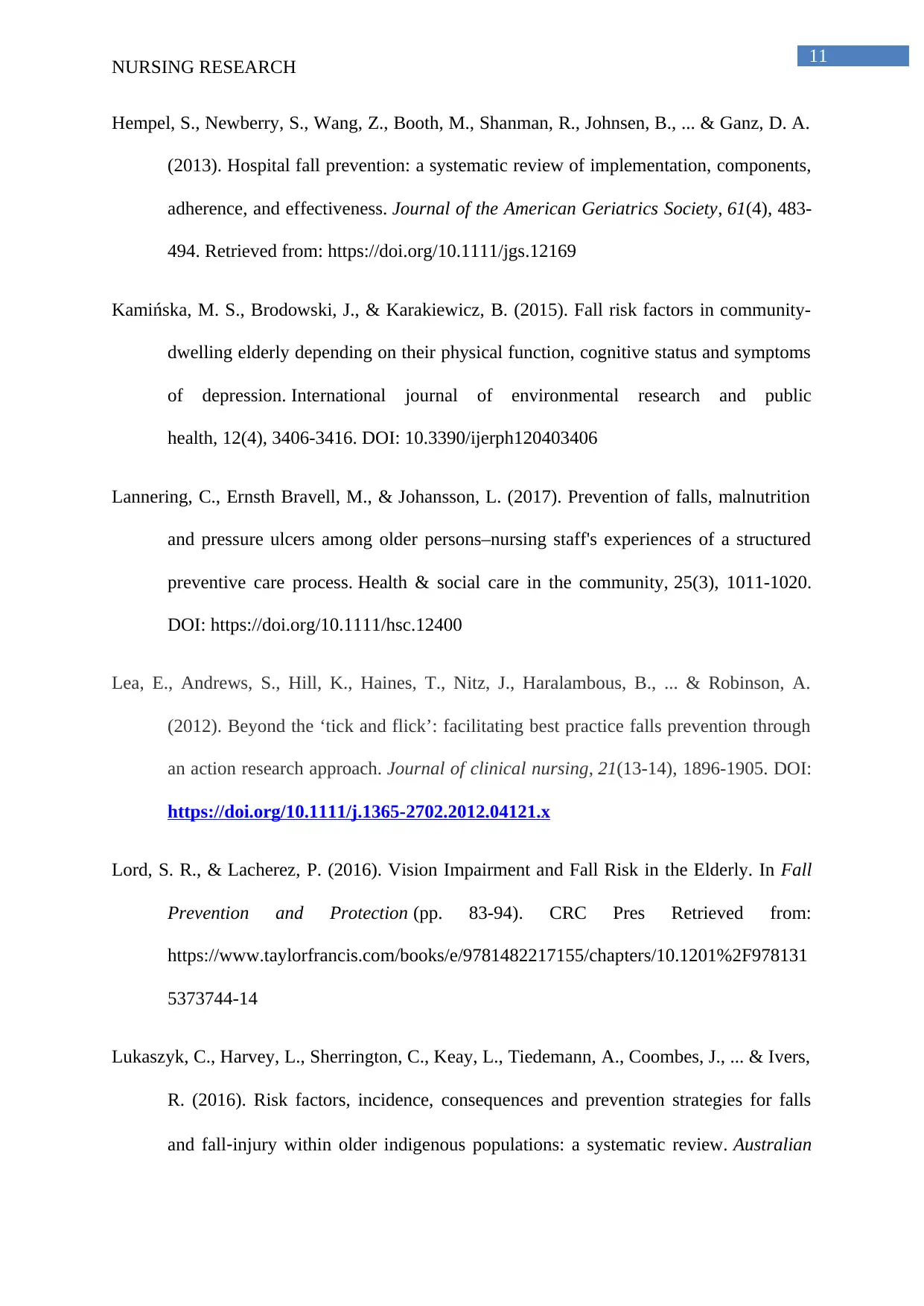
11
NURSING RESEARCH
Hempel, S., Newberry, S., Wang, Z., Booth, M., Shanman, R., Johnsen, B., ... & Ganz, D. A.
(2013). Hospital fall prevention: a systematic review of implementation, components,
adherence, and effectiveness. Journal of the American Geriatrics Society, 61(4), 483-
494. Retrieved from: https://doi.org/10.1111/jgs.12169
Kamińska, M. S., Brodowski, J., & Karakiewicz, B. (2015). Fall risk factors in community-
dwelling elderly depending on their physical function, cognitive status and symptoms
of depression. International journal of environmental research and public
health, 12(4), 3406-3416. DOI: 10.3390/ijerph120403406
Lannering, C., Ernsth Bravell, M., & Johansson, L. (2017). Prevention of falls, malnutrition
and pressure ulcers among older persons–nursing staff's experiences of a structured
preventive care process. Health & social care in the community, 25(3), 1011-1020.
DOI: https://doi.org/10.1111/hsc.12400
Lea, E., Andrews, S., Hill, K., Haines, T., Nitz, J., Haralambous, B., ... & Robinson, A.
(2012). Beyond the ‘tick and flick’: facilitating best practice falls prevention through
an action research approach. Journal of clinical nursing, 21(13-14), 1896-1905. DOI:
https://doi.org/10.1111/j.1365-2702.2012.04121.x
Lord, S. R., & Lacherez, P. (2016). Vision Impairment and Fall Risk in the Elderly. In Fall
Prevention and Protection (pp. 83-94). CRC Pres Retrieved from:
https://www.taylorfrancis.com/books/e/9781482217155/chapters/10.1201%2F978131
5373744-14
Lukaszyk, C., Harvey, L., Sherrington, C., Keay, L., Tiedemann, A., Coombes, J., ... & Ivers,
R. (2016). Risk factors, incidence, consequences and prevention strategies for falls
and fall‐injury within older indigenous populations: a systematic review. Australian
NURSING RESEARCH
Hempel, S., Newberry, S., Wang, Z., Booth, M., Shanman, R., Johnsen, B., ... & Ganz, D. A.
(2013). Hospital fall prevention: a systematic review of implementation, components,
adherence, and effectiveness. Journal of the American Geriatrics Society, 61(4), 483-
494. Retrieved from: https://doi.org/10.1111/jgs.12169
Kamińska, M. S., Brodowski, J., & Karakiewicz, B. (2015). Fall risk factors in community-
dwelling elderly depending on their physical function, cognitive status and symptoms
of depression. International journal of environmental research and public
health, 12(4), 3406-3416. DOI: 10.3390/ijerph120403406
Lannering, C., Ernsth Bravell, M., & Johansson, L. (2017). Prevention of falls, malnutrition
and pressure ulcers among older persons–nursing staff's experiences of a structured
preventive care process. Health & social care in the community, 25(3), 1011-1020.
DOI: https://doi.org/10.1111/hsc.12400
Lea, E., Andrews, S., Hill, K., Haines, T., Nitz, J., Haralambous, B., ... & Robinson, A.
(2012). Beyond the ‘tick and flick’: facilitating best practice falls prevention through
an action research approach. Journal of clinical nursing, 21(13-14), 1896-1905. DOI:
https://doi.org/10.1111/j.1365-2702.2012.04121.x
Lord, S. R., & Lacherez, P. (2016). Vision Impairment and Fall Risk in the Elderly. In Fall
Prevention and Protection (pp. 83-94). CRC Pres Retrieved from:
https://www.taylorfrancis.com/books/e/9781482217155/chapters/10.1201%2F978131
5373744-14
Lukaszyk, C., Harvey, L., Sherrington, C., Keay, L., Tiedemann, A., Coombes, J., ... & Ivers,
R. (2016). Risk factors, incidence, consequences and prevention strategies for falls
and fall‐injury within older indigenous populations: a systematic review. Australian
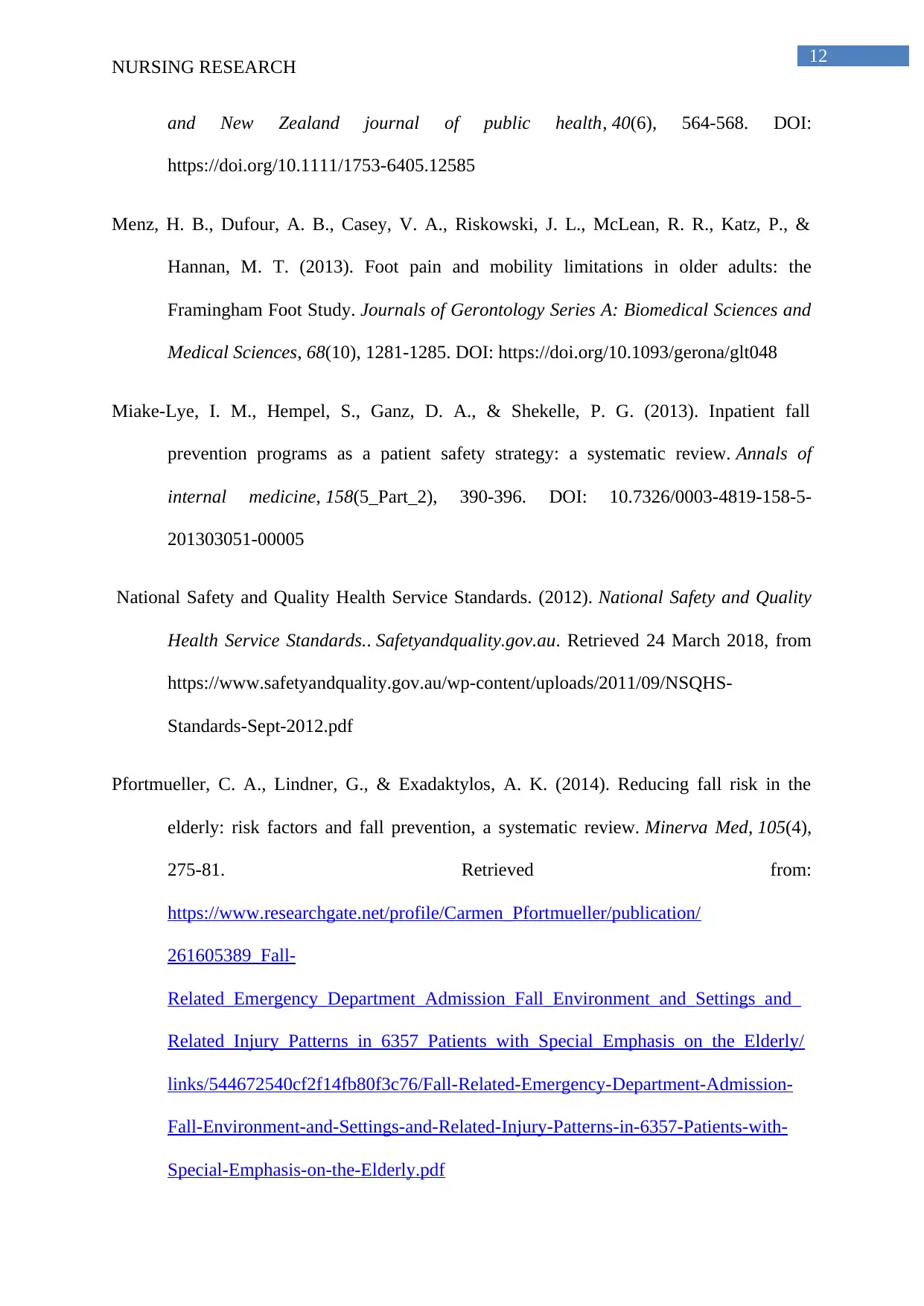
12
NURSING RESEARCH
and New Zealand journal of public health, 40(6), 564-568. DOI:
https://doi.org/10.1111/1753-6405.12585
Menz, H. B., Dufour, A. B., Casey, V. A., Riskowski, J. L., McLean, R. R., Katz, P., &
Hannan, M. T. (2013). Foot pain and mobility limitations in older adults: the
Framingham Foot Study. Journals of Gerontology Series A: Biomedical Sciences and
Medical Sciences, 68(10), 1281-1285. DOI: https://doi.org/10.1093/gerona/glt048
Miake-Lye, I. M., Hempel, S., Ganz, D. A., & Shekelle, P. G. (2013). Inpatient fall
prevention programs as a patient safety strategy: a systematic review. Annals of
internal medicine, 158(5_Part_2), 390-396. DOI: 10.7326/0003-4819-158-5-
201303051-00005
National Safety and Quality Health Service Standards. (2012). National Safety and Quality
Health Service Standards.. Safetyandquality.gov.au. Retrieved 24 March 2018, from
https://www.safetyandquality.gov.au/wp-content/uploads/2011/09/NSQHS-
Standards-Sept-2012.pdf
Pfortmueller, C. A., Lindner, G., & Exadaktylos, A. K. (2014). Reducing fall risk in the
elderly: risk factors and fall prevention, a systematic review. Minerva Med, 105(4),
275-81. Retrieved from:
https://www.researchgate.net/profile/Carmen_Pfortmueller/publication/
261605389_Fall-
Related_Emergency_Department_Admission_Fall_Environment_and_Settings_and_
Related_Injury_Patterns_in_6357_Patients_with_Special_Emphasis_on_the_Elderly/
links/544672540cf2f14fb80f3c76/Fall-Related-Emergency-Department-Admission-
Fall-Environment-and-Settings-and-Related-Injury-Patterns-in-6357-Patients-with-
Special-Emphasis-on-the-Elderly.pdf
NURSING RESEARCH
and New Zealand journal of public health, 40(6), 564-568. DOI:
https://doi.org/10.1111/1753-6405.12585
Menz, H. B., Dufour, A. B., Casey, V. A., Riskowski, J. L., McLean, R. R., Katz, P., &
Hannan, M. T. (2013). Foot pain and mobility limitations in older adults: the
Framingham Foot Study. Journals of Gerontology Series A: Biomedical Sciences and
Medical Sciences, 68(10), 1281-1285. DOI: https://doi.org/10.1093/gerona/glt048
Miake-Lye, I. M., Hempel, S., Ganz, D. A., & Shekelle, P. G. (2013). Inpatient fall
prevention programs as a patient safety strategy: a systematic review. Annals of
internal medicine, 158(5_Part_2), 390-396. DOI: 10.7326/0003-4819-158-5-
201303051-00005
National Safety and Quality Health Service Standards. (2012). National Safety and Quality
Health Service Standards.. Safetyandquality.gov.au. Retrieved 24 March 2018, from
https://www.safetyandquality.gov.au/wp-content/uploads/2011/09/NSQHS-
Standards-Sept-2012.pdf
Pfortmueller, C. A., Lindner, G., & Exadaktylos, A. K. (2014). Reducing fall risk in the
elderly: risk factors and fall prevention, a systematic review. Minerva Med, 105(4),
275-81. Retrieved from:
https://www.researchgate.net/profile/Carmen_Pfortmueller/publication/
261605389_Fall-
Related_Emergency_Department_Admission_Fall_Environment_and_Settings_and_
Related_Injury_Patterns_in_6357_Patients_with_Special_Emphasis_on_the_Elderly/
links/544672540cf2f14fb80f3c76/Fall-Related-Emergency-Department-Admission-
Fall-Environment-and-Settings-and-Related-Injury-Patterns-in-6357-Patients-with-
Special-Emphasis-on-the-Elderly.pdf
Paraphrase This Document
Need a fresh take? Get an instant paraphrase of this document with our AI Paraphraser
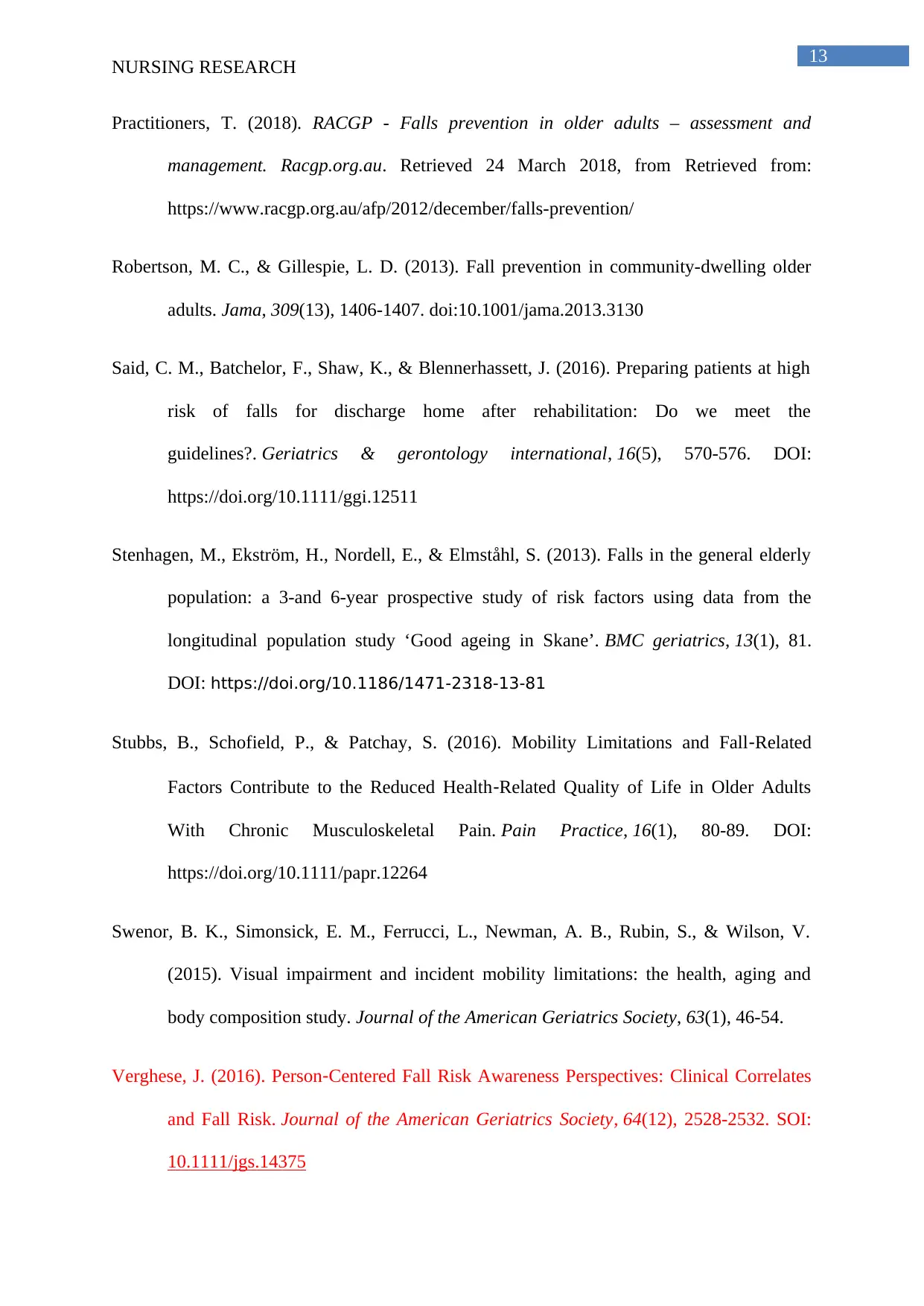
13
NURSING RESEARCH
Practitioners, T. (2018). RACGP - Falls prevention in older adults – assessment and
management. Racgp.org.au. Retrieved 24 March 2018, from Retrieved from:
https://www.racgp.org.au/afp/2012/december/falls-prevention/
Robertson, M. C., & Gillespie, L. D. (2013). Fall prevention in community-dwelling older
adults. Jama, 309(13), 1406-1407. doi:10.1001/jama.2013.3130
Said, C. M., Batchelor, F., Shaw, K., & Blennerhassett, J. (2016). Preparing patients at high
risk of falls for discharge home after rehabilitation: Do we meet the
guidelines?. Geriatrics & gerontology international, 16(5), 570-576. DOI:
https://doi.org/10.1111/ggi.12511
Stenhagen, M., Ekström, H., Nordell, E., & Elmståhl, S. (2013). Falls in the general elderly
population: a 3-and 6-year prospective study of risk factors using data from the
longitudinal population study ‘Good ageing in Skane’. BMC geriatrics, 13(1), 81.
DOI: https://doi.org/10.1186/1471-2318-13-81
Stubbs, B., Schofield, P., & Patchay, S. (2016). Mobility Limitations and Fall‐Related
Factors Contribute to the Reduced Health‐Related Quality of Life in Older Adults
With Chronic Musculoskeletal Pain. Pain Practice, 16(1), 80-89. DOI:
https://doi.org/10.1111/papr.12264
Swenor, B. K., Simonsick, E. M., Ferrucci, L., Newman, A. B., Rubin, S., & Wilson, V.
(2015). Visual impairment and incident mobility limitations: the health, aging and
body composition study. Journal of the American Geriatrics Society, 63(1), 46-54.
Verghese, J. (2016). Person‐Centered Fall Risk Awareness Perspectives: Clinical Correlates
and Fall Risk. Journal of the American Geriatrics Society, 64(12), 2528-2532. SOI:
10.1111/jgs.14375
NURSING RESEARCH
Practitioners, T. (2018). RACGP - Falls prevention in older adults – assessment and
management. Racgp.org.au. Retrieved 24 March 2018, from Retrieved from:
https://www.racgp.org.au/afp/2012/december/falls-prevention/
Robertson, M. C., & Gillespie, L. D. (2013). Fall prevention in community-dwelling older
adults. Jama, 309(13), 1406-1407. doi:10.1001/jama.2013.3130
Said, C. M., Batchelor, F., Shaw, K., & Blennerhassett, J. (2016). Preparing patients at high
risk of falls for discharge home after rehabilitation: Do we meet the
guidelines?. Geriatrics & gerontology international, 16(5), 570-576. DOI:
https://doi.org/10.1111/ggi.12511
Stenhagen, M., Ekström, H., Nordell, E., & Elmståhl, S. (2013). Falls in the general elderly
population: a 3-and 6-year prospective study of risk factors using data from the
longitudinal population study ‘Good ageing in Skane’. BMC geriatrics, 13(1), 81.
DOI: https://doi.org/10.1186/1471-2318-13-81
Stubbs, B., Schofield, P., & Patchay, S. (2016). Mobility Limitations and Fall‐Related
Factors Contribute to the Reduced Health‐Related Quality of Life in Older Adults
With Chronic Musculoskeletal Pain. Pain Practice, 16(1), 80-89. DOI:
https://doi.org/10.1111/papr.12264
Swenor, B. K., Simonsick, E. M., Ferrucci, L., Newman, A. B., Rubin, S., & Wilson, V.
(2015). Visual impairment and incident mobility limitations: the health, aging and
body composition study. Journal of the American Geriatrics Society, 63(1), 46-54.
Verghese, J. (2016). Person‐Centered Fall Risk Awareness Perspectives: Clinical Correlates
and Fall Risk. Journal of the American Geriatrics Society, 64(12), 2528-2532. SOI:
10.1111/jgs.14375

14
NURSING RESEARCH
NURSING RESEARCH
1 out of 15
Related Documents
Your All-in-One AI-Powered Toolkit for Academic Success.
+13062052269
info@desklib.com
Available 24*7 on WhatsApp / Email
![[object Object]](/_next/static/media/star-bottom.7253800d.svg)
Unlock your academic potential
© 2024 | Zucol Services PVT LTD | All rights reserved.





